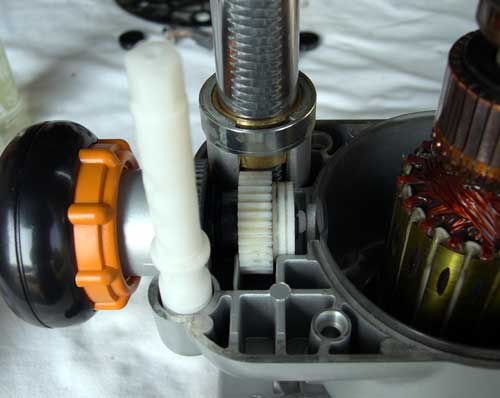Sorry to have raised some hackles, but I can only comment on what I read.
Streetpips, I'm sure you can raise the router when inverted, using the r-a-p, so can I, but when demonstrating this feature at shows, I'll always get someone to try to raise it inverted with the spring in, then notice the big difference with it out - the way it's supposed to be used. On seeing your comment, I thought I'd test my impression against yours. It was a fairly simple test, but it showed that removing the spring reduces the effort by a factor of three. I try not to be pedantic, but I couldn't have been aware that you were using past experience of another router as a comparison, could I? It may be, even now, that I've got hold of the wrong end again.
Christoph, nowhere in your postings does it say that your router was new (yours too, Gary M, omitted this fact as far as I can see). That will, perhaps, explain my amazed reaction to your not having the router to bits.
I still don't understand your statement about "side play" though, relating to the bushings and it would greatly assist if you'd expand a bit on that aspect - either here or via PM.
All my previous dealings and experience of this type of problem have involved machines that have done quite a bit of service and needed maintenance, but I mustn't make such assumptions in the future, especially if this is happening to new machines. Certainly nothing has come down from HQ about a rogue batch, similar problems, etc. or I would have posted the info immediately.
Christoph, you asked: 'Do you know anything about this I found on amazon "and the fine adjustment screw is an excellent idea. I've seen some complaints about backlash but, taking the backlash out is not an issue if one knows what one is doing."' This refers to the process I mentioned in my earliest response, being "kind" to the mechanism by raising above the required height with the r-a-p, then lowering to the actual required height with the fine adjuster.
Those that have bumped into me at Kempton Park and elsewhere know that, although I'm fairly blunt, I'll try anything to help. Looks like I need to try harder.
Ray.
Streetpips, I'm sure you can raise the router when inverted, using the r-a-p, so can I, but when demonstrating this feature at shows, I'll always get someone to try to raise it inverted with the spring in, then notice the big difference with it out - the way it's supposed to be used. On seeing your comment, I thought I'd test my impression against yours. It was a fairly simple test, but it showed that removing the spring reduces the effort by a factor of three. I try not to be pedantic, but I couldn't have been aware that you were using past experience of another router as a comparison, could I? It may be, even now, that I've got hold of the wrong end again.
Christoph, nowhere in your postings does it say that your router was new (yours too, Gary M, omitted this fact as far as I can see). That will, perhaps, explain my amazed reaction to your not having the router to bits.
I still don't understand your statement about "side play" though, relating to the bushings and it would greatly assist if you'd expand a bit on that aspect - either here or via PM.
All my previous dealings and experience of this type of problem have involved machines that have done quite a bit of service and needed maintenance, but I mustn't make such assumptions in the future, especially if this is happening to new machines. Certainly nothing has come down from HQ about a rogue batch, similar problems, etc. or I would have posted the info immediately.
Christoph, you asked: 'Do you know anything about this I found on amazon "and the fine adjustment screw is an excellent idea. I've seen some complaints about backlash but, taking the backlash out is not an issue if one knows what one is doing."' This refers to the process I mentioned in my earliest response, being "kind" to the mechanism by raising above the required height with the r-a-p, then lowering to the actual required height with the fine adjuster.
Those that have bumped into me at Kempton Park and elsewhere know that, although I'm fairly blunt, I'll try anything to help. Looks like I need to try harder.
Ray.





